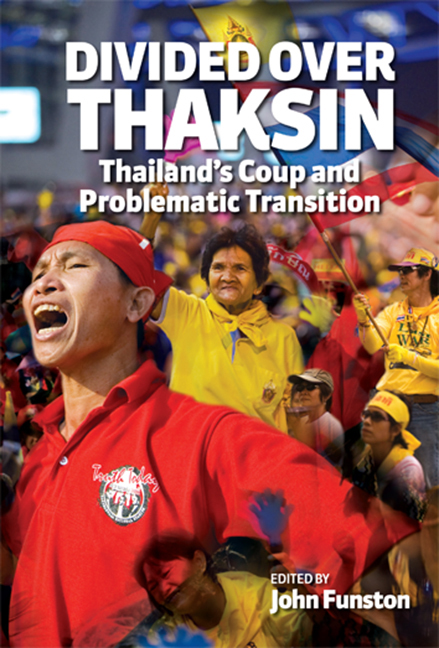Book contents
- Frontmatter
- Contents
- List of Tables and Figures
- List of Contributors
- Preface
- Introduction
- 1 Political Contests in the Advent of Bangkok's 19 September Putsch
- 2 The Tragedy of the 1997 Constitution
- 3 The NESAC, Civil Society, Good Governance and the Coup
- 4 Military Coup and Democracy in Thailand
- 5 Deconstructing the 2007 Constitution
- 6 Thailand's 2007 Constitution and Re-Emerging Democracy: Will Political Polarization Continue?
- 7 Untying the Gordian Knot: The Difficulties in Solving Southern Violence
- 8 Another Country: Reflections on the Politics of Culture and the Muslim South
- 9 Governance in the South: Is Decentralization an Option?
- 10 Tradition and Reform in Islamic Education in Southern Thailand
- 11 The Economy under the Thaksin Government: Stalled Recovery
- 12 The Thai Economy after the Coup
- 13 The Impact of Political Uncertainty on Business
- Index
Introduction
Published online by Cambridge University Press: 21 October 2015
- Frontmatter
- Contents
- List of Tables and Figures
- List of Contributors
- Preface
- Introduction
- 1 Political Contests in the Advent of Bangkok's 19 September Putsch
- 2 The Tragedy of the 1997 Constitution
- 3 The NESAC, Civil Society, Good Governance and the Coup
- 4 Military Coup and Democracy in Thailand
- 5 Deconstructing the 2007 Constitution
- 6 Thailand's 2007 Constitution and Re-Emerging Democracy: Will Political Polarization Continue?
- 7 Untying the Gordian Knot: The Difficulties in Solving Southern Violence
- 8 Another Country: Reflections on the Politics of Culture and the Muslim South
- 9 Governance in the South: Is Decentralization an Option?
- 10 Tradition and Reform in Islamic Education in Southern Thailand
- 11 The Economy under the Thaksin Government: Stalled Recovery
- 12 The Thai Economy after the Coup
- 13 The Impact of Political Uncertainty on Business
- Index
Summary
In August 2006, former Prime Minister Anand Panyarachun warned that Thailand risked becoming a failed state: “If Thai society is … divided and there is so much hate, and the environment is conducive to prolonging this hate, and to sustaining conflict, it is frightening, very frightening.” If allowed to continue, the government would be unable to administer the country. On 19 September the military staged a coup which promised to resolve these problems and return Thailand to democratic rule. Yet by late 2008 Anand' prediction appeared close to realization. In November, opponents of former Prime Minister Thaksin Shinawatra had blockaded and shut down Bangkok' two airports for more than a week, causing chaos to international travellers and immobilizing government. Wearing yellow shirts as a symbol of their loyalty to the monarchy, the People' Alliance for Democracy (PAD), clashed intermittently with red-shirted members of the United Front of Democracy Against Dictatorship (UDD) aligned to Thaksin. The deadlock was broken only by a court decision banning the ruling party and removing Prime Minister Somchai Wongsawat from office.
The airport blockade was the culmination of a turbulent year in Thai politics. The first elections after the 2006 coup were held in December 2007, and gave an overwhelming victory to the Thaksin-aligned People Power Party (PPP). It won 233 of 480 seats in its own right, and five closely allied parties won 82 seats. A coalition government of all parties was soon established, minus the Democrat Party which won only 165 seats and remained in opposition.
The PPP government, led by controversial veteran Samak Sundaravej, was soon besieged by street protests. In May 2008 a revived PAD, whose continued protests against the Thaksin administration during 2006 paved the way for the coup, protested against mooted constitutional changes. Those changes were aimed at removing from the charter provisions intended to weaken Thaksin and his allies. Soon the PAD demanded that the government give up power, and when Samak refused, stormed and occupied Government House on 26 August. In September Samak was forced to relinquish power when the Constitutional Court ruled against him, finding that by hosting two commercial television cooking shows he had violated constitutional provisions against conflicts of interest. A new PPP-dominated government, headed by Somchai (Thaksin' brother-in-law) took power and the PAD escalated its Campaign.
- Type
- Chapter
- Information
- Divided Over ThaksinThailand's Coup and Problematic Transition, pp. xiii - xxiPublisher: ISEAS–Yusof Ishak InstitutePrint publication year: 2009

